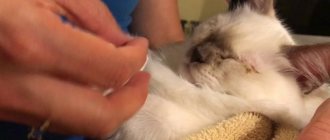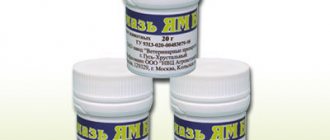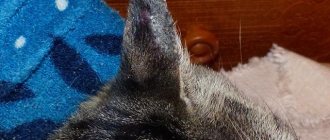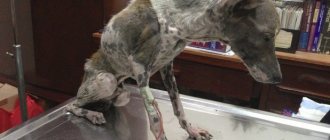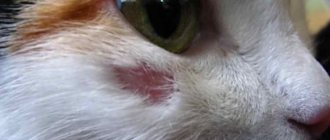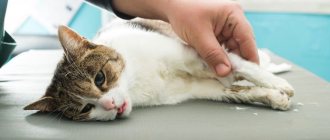“Aversectin ointment” is a frequently used remedy in veterinary medicine for the topical treatment of cats, dogs and parrots. Used to eliminate skin diseases caused by parasites. For the treatment of animals, the drug is prescribed at a concentration of 0.05% of the active substance.
"Aversectin ointment" can be used to treat young cats
Features of “Aversectin ointment” (0.05%)
A veterinary drug for external use, which is used in the treatment of the consequences of exposure to ticks and fleas, including when the patient has demodicosis and lichen. Among the components of the medication, aversectin C stands out, providing the main therapeutic effect on the skin and the pet’s body as a whole. The effect of the main substance is enhanced by the glycerol component and polyethylene oxide.
The active ingredient of the ointment is classified as an insectoacaricidal component that has a general and local effect. The main effect is on parasites of the group that cause demodicosis and sarcoptic mange. The ointment is effective in the presence of eggs and mature harmful organisms.
Attention! A veterinarian can prescribe “Aversectin ointment” to suppress violations of the integrity and inflammation of the epidermis in any fur-bearing animals, including rabbits and hamsters.
Aversectin successfully fights ear mites
Analogs
Aversectin ointment is an excellent choice for treating your pet. But sometimes its use may be impossible. For example, a veterinarian has determined that a cat has an intolerance to a compound.
Then similar drugs for treating parasites will come to the rescue. And these are acaromectin, lamisil, itracosanol, mycoseptin, sulfur ointment and ordermil.
In addition to ointments against parasites, it is possible to use drugs in granules and tablets. Currently, Alben S, Bravecto, Azinox, Febtal and Dronal have performed best among them.
You may be interested in: Rules for using the drug "Duphalight" in the treatment of cats
The principle of exposure to animal skin
As already mentioned, the main effect when using the drug is obtained due to the active effect of aversectin C on the skin. This substance is able to affect chlorine ions, reducing its concentration. It is chlorine that actively penetrates from the parasite’s body into the animal’s cells, which causes a negative reaction.
The effect on ions occurs not only in the skin of an infected and sick pet, but also directly in the cells of ticks, fleas and other harmful microorganisms. Due to impaired chlorine metabolism, nervous reactions throughout the body of the pathogen are inhibited, which causes its rapid death.
After the active component gets on the skin of a cat, dog or parrot, the ointment immediately begins to accumulate in places where parasitic microorganisms are most concentrated. The processes of regeneration and cleansing of the epidermis are produced. The maximum level of the active ingredient is reached after 3-5 days.
The drug is best tolerated by cats and dogs
The undigested drug is excreted naturally within two weeks with the animal’s excrement. “Aversectin ointment” is prescribed exclusively locally, which eliminates the occurrence of serious side effects, irritating effects that cause mutations, as well as acute allergic reactions. The drug is well tolerated during long-term therapy in all animals and birds. The ointment is used only in the field of veterinary medicine.
Attention! In the pharmacy chain you can purchase jars of “Aversectin ointment” in volumes from 15 to 500 g. Regardless of how long the medicine has been used, once opened it can be stored for up to two years, just like the original packaging.
Composition and principle of action
Aversectin ointment is a veterinary drug, and therefore it is used only to eliminate the consequences of tick lesions in animals - dogs, cats, parrots. This drug contains aversectin C, which provides the main therapeutic effect. Also, auxiliary components contribute to its strengthening - distilled glycerin (glycerol), polyethylene oxide-400 and polyethylene oxide-1500.
Aversectin C represents a group of insectoacaricidal drugs with systemic and contact action. It is designed for mature and larval ticks of the species Demodex canis and sarcoptic mites.
This drug promotes healing due to the presence of an active component, aversectin C, which has the ability to change the level of concentration of chloride ions that penetrate the muscle and nerve cell membranes of parasites. It is used to target gamma-aminobutyric acid receptors and glutamate-sensitive chloride channels. As a result of exposure to chlorine ions, the conduction of nerve impulses is disrupted, and this causes paralysis of the parasite and its subsequent death.
As a result of treating the diseased skin of a cat or parrot with the drug, aversectin C begins to act, which stimulates the activity of the skin in places where parasites are most concentrated, is absorbed and has a general insectoacaricidal effect. From the moment of application of the drug, it takes about 3-5 days for its concentration level in the blood plasma to reach its maximum. After 10–12 days, aversectin C is completely excreted from the body, mainly in feces.
Aversectin ointment does not have a negative impact on health, so irritating, teratogenic, mutagenic, sensitizing, embryotoxic effects, which are characteristic of a number of other similar drugs, cannot be expected. Even with long-term use, this drug does not cause adverse reactions in fur-bearing animals, dogs, cats and rabbits. However, it should not be used on humans.
Indications and contraindications for the use of the medication
The veterinarian prescribes “Aversectin ointment” for exposure to blood-sucking insects (entomosis), after diagnosing scabies mites (otodectosis), and lichen and tick-borne rashes (notoedrosis, sarcoptic mange, and demodicosis).
You should not apply the veterinary drug if the following contraindications are detected in your pet:
- infectious foci on the epidermis and other body systems;
- exhaustion and malnutrition of the pet;
- recovery period after a serious illness of any nature;
- period of pregnancy and lactation;
- kittens and puppies up to 8 weeks;
- individual intolerance to the active and auxiliary components.
Attention! The drug can be used for mixed forms of dermatological disorders. If there are several skin disorders, the ointment dosage is used for the disorder that requires a larger dose of the active substance.
When using the ointment, you should make sure that there are no contraindications for your pet.
General rules for applying ointment
In order for the active substance to have the best possible effect on the affected area of the skin, you should carefully follow the recommendations:
- completely remove hair from the affected area of the body;
- rinse the epidermis thoroughly and dry it;
- Remove scabs and crusts as carefully and thoroughly as possible if they have formed;
- To prevent the animal from accidentally licking the ointment during the procedure and preventing it from being applied, put a muzzle or any other restraining device on the pet;
- It is recommended to rub in the medication with a sterile swab or a medical spatula;
- if the problem is related to the effect of lice or fleas on the epidermis, there is no need to cut the hair;
- When applying the active substance to the auricle, it should first be massaged and, if possible, also cleaned well.
Attention! The owner of the animal is obliged to take care of his own safety. Rub the medication only while wearing rubber gloves. After treatment, hands are washed with plenty of water and soap.
Limiting device to prevent licking of the drug
Instructions for use
The ointment is applied to diseased areas, covering 1-1.5 cm of unaffected epidermis. The number of treatments depends on what disorder the pet suffers from. Typically, treatment sessions are carried out two to five times with a mandatory one-week break between sessions. The medication is distributed in a thin layer only once per day.
The exact treatment regimen can be found below.
Table 1. Frequency of application of Aversectin ointment, taking into account the disease
| Pet | Pathology | Frequency of use and break | Peculiarity |
| Rabbits | Psoroptosis | 2 times every 5-7 days | |
| Dogs of any breed | Demodicosis: squamous type of disorder (scaly form) | 3 times every 5-7 days | |
| Demodicosis: pustular type of disorder (pyodemodecosis) | 7 times weekly, course of therapy – 7 weeks | Violations are treated exclusively in complex therapy. | |
| Demodicosis: mixed type of disease | 7 times weekly, course of therapy – 7 weeks. For extensive skin disorders, also 7 treatments every 5 days | ||
| Dogs and cats |
| To make it easier to apply the medicine, it can be heated in warm water by simply lowering the packaging for a while. This method of use is especially suitable for treating animals with otodectosis - ear mites. | |
| Entomoses of various types (exposure to ticks, fleas and other blood-sucking microorganisms) | 2 times every 5-7 days | Rubbed in against hair growth. For ease of distribution, it is also recommended to melt the medication in warm water. To prevent a new infection in the near future, veterinarians recommend replacing all animal sleeping bags and, if possible, treating the apartment from blood-sucking insects |
Aversectin actively fights against all types of ticks
- If your pet has large areas of painful skin on its body, it should be treated in parts. On the first day, “Aversectin ointment” is distributed over half of the diseased epidermis, on the second day the remaining area of the body is treated.
- If at the same time complicated forms of the disorder are diagnosed in a sick individual, accompanied by infections and fungi, therapy should be supplemented with immunomodulators, antibiotics and antifungals.
- When eliminating ear-type scabies, apply the ointment to both ears, regardless of whether the animal’s second ear canal is affected.
- In severe cases of otodectosis (ear scabies), after applying the ointment, be sure to fold the ear in half again and massage it well to evenly distribute the active substance.
- For entomosis of various natures with a large accumulation of fleas, lice, lice, the ointment should be rubbed into the epidermis with a brush.
- If necessary, after a full course of therapy, another one can be performed if the treatment does not give the desired result.
- When treating parrots, the treatment regimen is always developed individually.
Attention! We can speak about the success of the treatment only after 2 tests in the laboratory. If both results are negative, the therapy has been carried out correctly.
Aversectin C eliminates dermatological disorders in birds
Pharmacological properties
The main component aversectin C is a biological insectoacaricide isolated from the waste products of the soil fungus Streptomyces avermitilis. It acts on arthropods and insects as a neurotoxin. Penetrating into the body of pests, it affects nerve cells and disrupts the transmission of impulses. Parasites lose the ability to feed, move and die.
Aversectin C in the ointment destroys:
- demodectic mites;
- scabies;
- ear;
- fleas;
- lice;
- lice eaters.
After application to the skin, aversectin penetrates into the habitats of parasites - the epidermis, follicles, sebaceous glands and destroys pests upon direct contact. After absorption, it enters the bloodstream and acts “from the inside.” Parasites die when they are saturated with blood and lymph.
In the first 3–5 days after treatment, the concentration of aversectin in the blood increases. Then it is excreted along with feces for 10 to 12 days. The drug destroys larvae and mature individuals; it has no effect on pest eggs. Well tolerated by dogs due to the low concentration of insectoacaricide, but toxic to bees and fish. Aversectin ointment is even prescribed to people for the treatment of demodicosis when other means do not help.
Adverse reactions and overdose
In the absence of violations of the instructions, the occurrence of an overdose and undesirable effects is excluded. If the active substance is intolerant and the recommended treatment regimen is violated, the sick pet experiences skin irritation, redness, and itching. In exceptional cases, digestive reactions in the form of nausea, vomiting and diarrhea may occur.
What to do if your dog has diarrhea?
Attention! Despite the fact that no serious adverse reactions from the body are recorded when using Aversectin Ointment, the appearance of some undesirable symptoms in a particular animal cannot be ruled out. If you notice health problems in your cat, dog, parrot or other fur-bearing animal after using the ointment, you should immediately consult a veterinarian.
It is recommended to apply the medication to the pet’s skin after examination by a veterinarian.
Analogues of veterinary medicine
The drug has several similar effects to medications against lichen and parasitic effects.
Table 2. Analogues of aversectin ointment
| Analogue | Form | Peculiarities |
| "Novertine ointment" | Ointment |
|
| "Amidel-gel" | Gel |
|
| "Phytoelite" | Shampoo |
|
| "Baneotsin" | Ointment |
|
Aversectin ointment for animals against external parasites
Aversectin ointment is used to treat dogs, cats and fur-bearing animals with sarcoptic mange, notoedrosis, otodectosis, demodicosis and entomosis; rabbits - with psoroptosis.
COMPOSITION AND FORM OF RELEASE Aversectin ointment is an insecto-acaricidal agent per 1 g containing 0.5 mg of aversectin C and auxiliary components. The drug is a homogeneous creamy mass of yellowish color, with a weak specific odor for external use. Packaged in polymer jars of 15, 30 and 500 g. PHARMACOLOGICAL PROPERTIES Aversectin C is a natural avermectin complex isolated by microbiological synthesis using the culture of Streptomyces avermitilis. Aversectin ointment has a wide spectrum of insecticidal and acaricidal action against sarcoptic and demodectic mites, lice, fleas and lice. The mechanism of action of the active ingredient, aversectin C1, is its effect on the magnitude of the current of chlorine ions through the membranes of the nerve and muscle cells of the parasite. The main targets are glutamate-sensitive chloride channels, as well as gamma-aminobutyric acid receptors. A change in the current of chlorine ions disrupts the conduction of nerve impulses, which leads to paralysis and death of the parasite. Aversectin ointment is low-toxic for warm-blooded animals, in recommended doses it does not have locally irritating, allergic, embryotoxic or teratogenic effects, and does not have cumulative properties. INDICATIONS For the treatment of dogs, cats, fur-bearing animals and rabbits with acarosis (notoedrosis, sarcoptic mange, otodectosis, demodicosis, etc.) and entomosis (felicolosis, trichodectosis, linognathosis, ctenocephalosis, etc.). DOSES AND METHOD OF APPLICATION The ointment is applied externally to the affected surface of the skin or into the ear at the rate of 0.2 - 0.3 g per 1 cm². For acarosis, the affected areas of the skin are washed and wiped dry, the ears are cleaned of crusts and scabs, and the hair is cut off. The ointment is spread with a spatula, a glass rod, or a cotton-gauze swab. When applying the ointment into the ear canal, the auricle is folded in half lengthwise and massaged at the base. When applying the ointment to other parts of the body (head, torso, paws), rub it vigorously with a brush or wide stopper into the affected areas. For convenience, the ointment can be melted in a manufacturer’s jar in hot water and used warm. For psoroptosis, otodectosis, and notoedrosis, the ointment is used twice with an interval of 5–7 days. For demodicosis (squamous form) - three times with an interval of 6 - 7 days; (pustular and mixed form) - seven times with an interval of 7 days, with multiple lesions with an interval of 5 days. Treatment of pustular and mixed forms of demodicosis should be comprehensive and, in addition to etiotropic treatment, immunocorrective, antimicrobial and antifungal therapy should be carried out. In order to monitor the effectiveness of treatment, 7 days after the last treatment, deep scrapings are made from the affected and healthy areas of the skin and examined for the presence of mites. If they are detected, the processing is repeated. For entomoses (lice, fleas, lice eaters), the ointment is rubbed against the growth of the hair (can be melted) into places inaccessible for licking (in the back of the head). The ointment is applied twice with an interval of 7–10 days; if necessary, the treatment can be repeated. To prevent fleas from breeding and reinfecting pets, bedding should be changed. SIDE EFFECTS With increased individual sensitivity to avermectin in animals, allergic reactions and vomiting are possible. CONTRAINDICATIONS Individual hypersensitivity to the components of the ointment. Do not use the drug for treating pregnant and lactating females, as well as in animals under 2 months of age. SPECIAL INSTRUCTIONS
When handling the drug, you should use rubber gloves. If the ointment accidentally gets on the skin or mucous membranes, you should immediately remove the product using a cotton swab and then wash with warm water. During the procedure, drinking, smoking and eating are prohibited. After handling, wash your hands thoroughly with warm water and soap. Slaughter of rabbits for meat is permitted 14 days after the last treatment. STORAGE CONDITIONS: Keep dry and cool, protected from direct sunlight, out of the reach of children and animals. Separated from food and feed at temperatures from 0 to 20 ºС. Shelf life: 2 years.
Owner's personal precautions
When applying Aversectin Ointment, it is imperative to protect not only the animal from getting the active substance into the mouth and mucous membranes of the eyes and nose, but also the owner himself. When conducting therapy for a pet, its owner must adhere to the following rules:
- do not consume food, water, or smoke directly while applying the ointment and until your hands are washed;
- within 24 hours after using the ointment, you should not touch the animal or allow it into your arms; if possible, isolate the pet in a separate room;
- when the veterinary preparation comes into contact with the mucous membrane, it must be rinsed with a sufficient volume of water;
- In case of accidental ingestion, including by a pet, you need to take a sorbent; regular “Activated Carbon” or “Polysorb” will do.
The pet owner must apply the ointment while protecting his hands.
Feedback from pet owners
Breeders and pet lovers speak positively about the use of the drug. “Aversectin ointment” allows you to eliminate the symptoms of lichen, demodicosis, scabies mites and other dermatological diseases in a short period of time. According to animal owners, the results of the drug are already noticeable after the first use. The pet gets rid of itching, becomes more active, and shows interest in games and walks.
Negative effects during the treatment of “Aversectin ointment” were recorded only with increased sensitivity, which appeared after the first treatment. In this case, most often only mild irritability and redness of the epidermis were noted. The adverse reaction went away within a few days.
Video - Skin diseases in animals
Attention! When using the medication on rabbits, their meat is suitable for consumption only two weeks after the end of therapy. If for some reason the slaughter was earlier, the meat can be given to other animals, but humans are strictly prohibited from consuming it.
With the correct treatment regimen, the animal returns to normal in one course
“Aversectin ointment” is a popular remedy for suppressing dermatological pathologies in the field of veterinary medicine. It is most often used to suppress skin diseases in cats and dogs, but the drug can be used in any animals with dense fur and birds. In the absence of violation of the instructions, it never shows any adverse reactions and is easily tolerated, including during long-term therapy. Despite excellent tolerability, it is recommended to use aversectin in a 0.05% concentration only under the guidance of a veterinarian.
Composition and release form of Aversectin ointment
Aversectin ointment 0.05% is used to combat cat skin parasites: insects and mites. Aversectin ointment is produced by Pharmbiomedservice LLC (Russia).
The ointment is homogeneous and does not contain additional visible or tangible inclusions. Its color is white with some yellowness. The ointment has a slight specific odor.
100 g of ointment contains:
- active ingredient: aversectin C - 50 mg;
- polyoxyethylene 1500;
The product is packaged in plastic containers containing 15, 20, 30, 60 and 500 g of ointment. Each container is equipped with a plastic lid, which provides control when opening the package for the first time.
Plastic ointment jars are equipped with lids with first opening control
Plastic containers have external markings indicating:
- name of the manufacturer of the medicinal product;
- trademark;
- manufacturer's address;
- name of the medicinal product;
- how to use the drug;
- the mass of the product contained in the package;
- name and content of the active ingredient;
- serial number;
- date of manufacture of the drug;
- best before date;
- conditions necessary for storing the product;
- veterinary purpose of the drug.
All packaging of the product is provided with annotations on its use.
The ointment has a uniform consistency and white color, perhaps a yellowish tint

